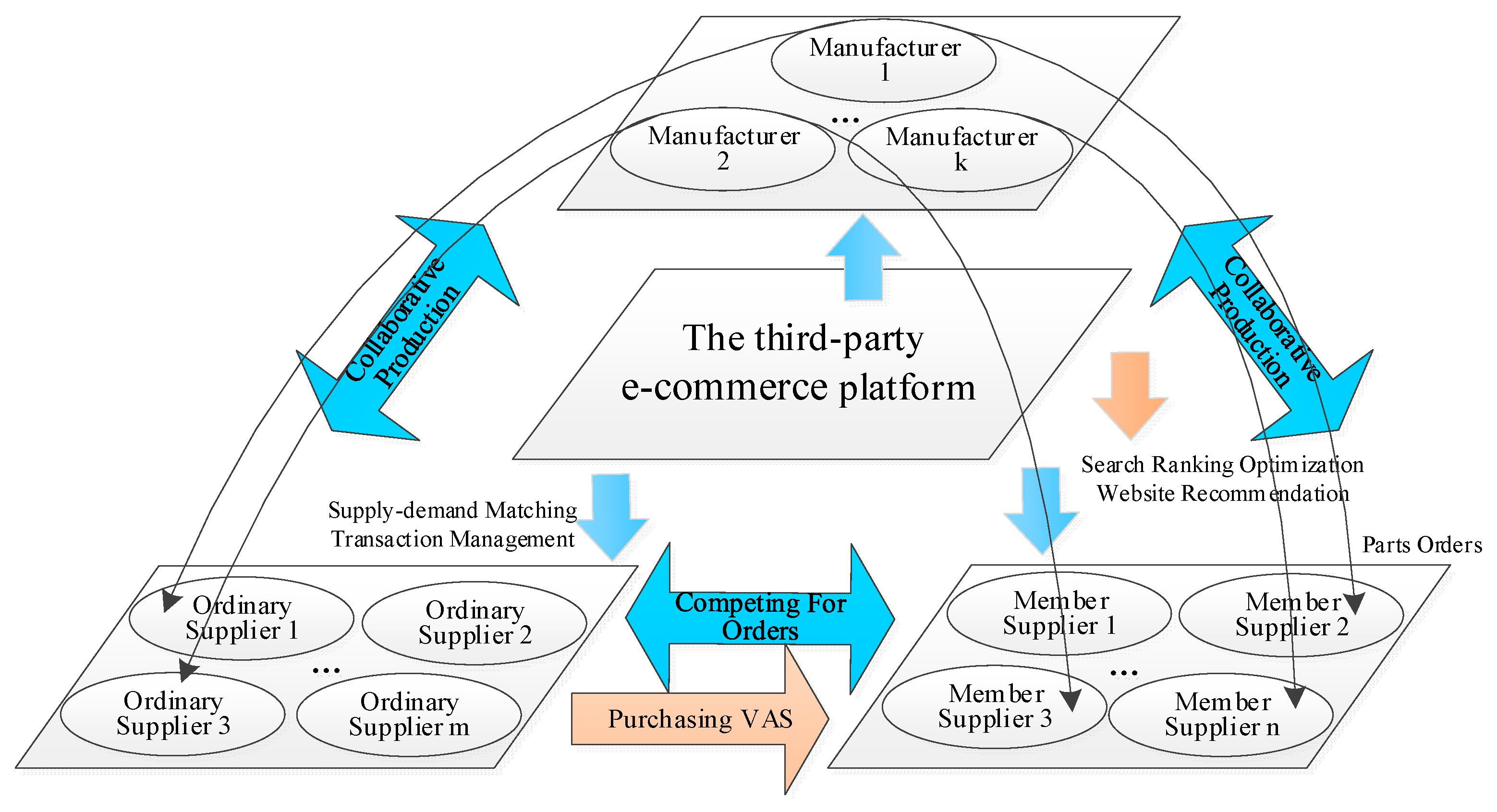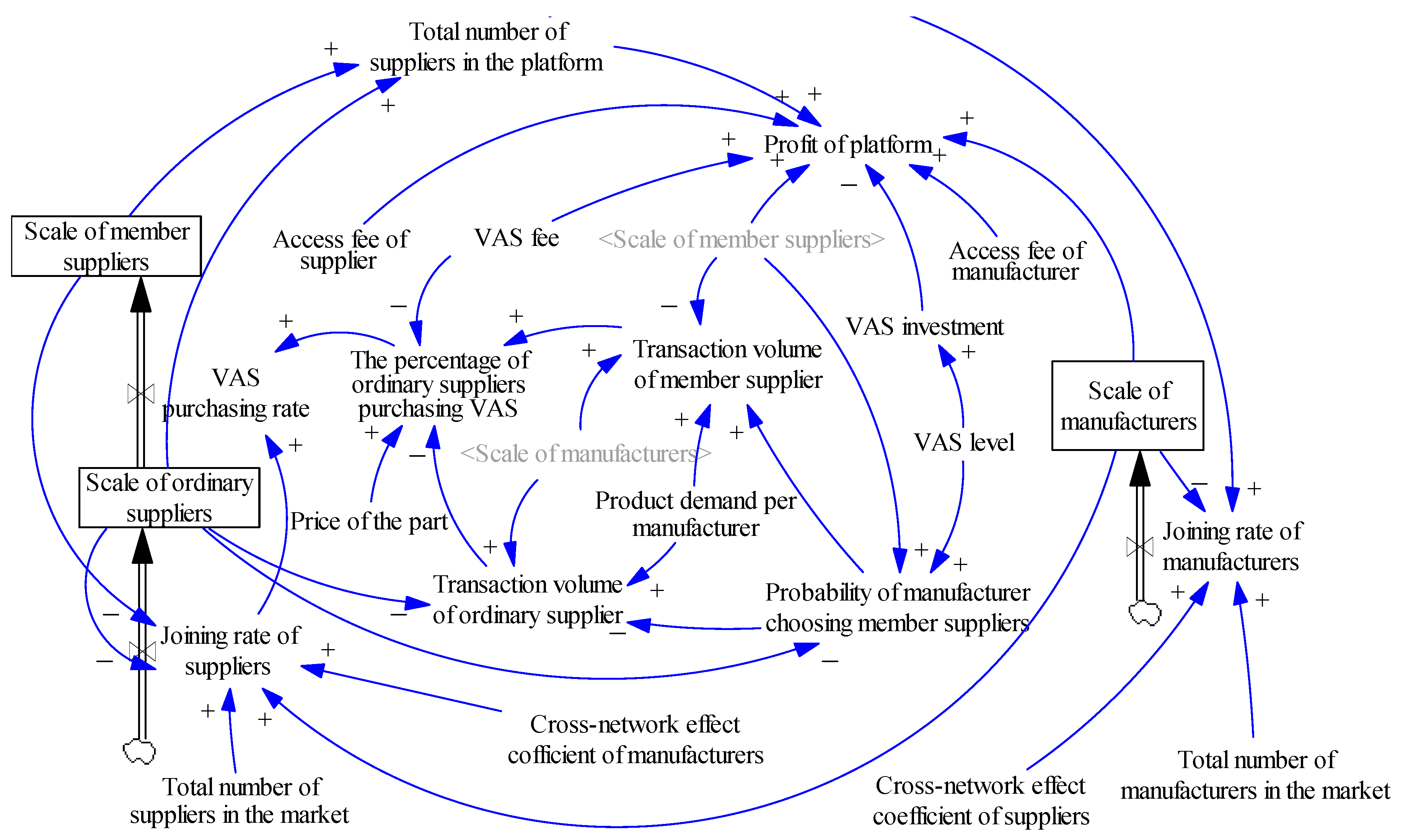Simulation Modeling and Analysis on the Value-Added Service of the Third-Party E-Commerce Platform Supporting Multi-Value Chain Collaboration
Abstract
:1. Introduction
2. Literature Review
3. Problem Description
4. Model Establishment
4.1. System Dynamics Diagram
- Total number of suppliers on the platform Joining rate of manufacturers Scale of manufacturers Joining rate of suppliers Scale of ordinary suppliers Scale of member suppliers Total number of suppliers on the platform
- Total number of suppliers on the platform Joining rate of suppliers Scale of ordinary suppliers Scale of member suppliers Total number of suppliers on the platform
- Scale of manufacturers Joining rate of suppliers Scale of ordinary suppliers Scale of member suppliers Total number of suppliers on the platform Joining rate of manufacturers Scale of manufacturers
- Scale of manufacturers Joining rate of manufacturers Scale of manufacturers
- VAS level Probability of manufacturer choosing member suppliers Transaction volume of member suppliers The percentage of ordinary suppliers purchasing VAS VAS purchasing rate Scale of member suppliers Profit of platform
- VAS level Probability of manufacturer choosing member suppliers Transaction volume of ordinary supplier The percentage of ordinary suppliers purchasing VAS VAS purchasing rate Scale of member suppliers Profit of platform
- VAS level VAS investment Profit of platform
4.2. Quantitative Formulations
5. Simulation and Analysis
5.1. Analysis of the VAS and Charging Strategies of the Platform
5.2. The Impact of the Cross-Network Effect on the VAS and Charging Strategies
6. Conclusions
Author Contributions
Funding
Institutional Review Board Statement
Informed Consent Statement
Data Availability Statement
Conflicts of Interest
References
- Boillat, T.; Legner, C. From on-premise software to cloud services: The impact of cloud computing on enterprise software vendors’ business models. J. Theor. Appl. Electron. Commer. Res. 2013, 8, 39–58. [Google Scholar] [CrossRef]
- Lee, I. Pricing and profit management models for SaaS providers and IaaS providers. J. Theor. Appl. Electron. Commer. Res. 2021, 16, 859–873. [Google Scholar] [CrossRef]
- Chen, Q.; Xu, Q.; Wu, C. Dynamic matching in cloud manufacturing considering matching costs. Complexity 2019, 2019, 8398356. [Google Scholar] [CrossRef]
- Basu, A.; Bhaskaran, S.; Mukherjee, R. An analysis of search and authentication strategies for online matching platforms. Manag. Sci. 2019, 65, 2412–2431. [Google Scholar] [CrossRef]
- He, J.; Zhang, J.; Gu, X. Research on sharing manufacturing in Chinese manufacturing industry. Int. J. Adv. Manuf. Technol. 2019, 104, 463–476. [Google Scholar] [CrossRef]
- Guo, Y.; Bao, Y.; Stuart, B.J.; Le-Nguyen, K. To sell or not to sell: Exploring sellers’ trust and risk of chargeback fraud in cross-border electronic commerce. Inf. Syst. J. 2018, 28, 359–383. [Google Scholar] [CrossRef]
- Ghomi, E.J.; Rahmani, A.M.; Qader, N.N. Cloud manufacturing: Challenges, recent advances, open research issues, and future trends. Int. J. Adv. Manuf. Technol. 2019, 102, 3613–3639. [Google Scholar] [CrossRef]
- Dou, G.; He, P.; Xu, X. One-side value-added service investment and pricing strategies for a two-sided platform. Int. J. Prod. Res. 2016, 54, 3808–3821. [Google Scholar] [CrossRef]
- Rochet, J.C.; Tirole, J. Platform competition in two-sided markets. J. Eur. Econ. Assoc. 2003, 1, 990–1029. [Google Scholar] [CrossRef]
- Evans, D.S. Some empirical aspects of multi-sided platform industries. Rev. Netw. Econ. 2003, 2, 191–209. [Google Scholar] [CrossRef]
- Winkler, T.J.; Ziekow, H.; Weinberg, M. Municipal benefits of participatory urban sensing: A simulation approach and case validation. J. Theor. Appl. Electron. Commer. Res. 2012, 7, 101–120. [Google Scholar] [CrossRef]
- Zhang, X.; Yuan, J.; Dan, B.; Sui, R.; Li, W. The evolution mechanism of the multi-value chain network ecosystem supported by the third-party platform. J. Ind. Manag. Optim. 2022, 18, 4071–4091. [Google Scholar] [CrossRef]
- Zhang, X.; Sui, R.; Dan, B.; Guan, Z. Bilateral value-added services and pricing strategies of the third-party platform considering the cross-network externality. Comput. Ind. Eng. 2021, 155, 107196. [Google Scholar] [CrossRef]
- Chen, D.; Zhou, Z.; Ma, Y.; Pham, D.T. Design of agent-based supply chain-oriented virtual enterprise platform. Kybernetes 2011, 40, 800–806. [Google Scholar] [CrossRef]
- Song, T.; Liu, H.; Wei, C.; Zhang, C. Common engines of cloud manufacturing service platform for SMEs. Int. J. Adv. Manuf. Technol. 2014, 73, 557–569. [Google Scholar] [CrossRef]
- Rau, H.; Chen, T.F.; Chen, C.W. Develop a negotiation framework for automating B2B processes in the RosettaNet environment using fuzzy technology. Comput. Ind. Eng. 2009, 56, 736–753. [Google Scholar] [CrossRef]
- Yin, Y.; Zhou, J.; Zhang, C.; Chen, D. Adaptive SLA mechanism for service sharing in virtual environments. Kybernetes 2016, 45, 1036–1051. [Google Scholar] [CrossRef]
- Renna, P.; Argoneto, P. Production planning and automated negotiation for SMEs: An agent based e-procurement application. Int. J. Prod. Econ. 2010, 127, 73–84. [Google Scholar] [CrossRef]
- Valilai, O.F.; Houshmand, M. A collaborative and integrated platform to support distributed manufacturing system using a service-oriented approach based on cloud computing paradigm. Robot. Comput.-Integr. Manuf. 2013, 29, 110–127. [Google Scholar] [CrossRef]
- Bakos, Y.; Katsamakas, E. Design and ownership of two-sided networks: Implications for Internet platforms. J. Manag. Inf. Syst. 2008, 25, 171–202. [Google Scholar] [CrossRef]
- Laili, Y.; Tao, F.; Zhang, L.; Sarker, B.R. A study of optimal allocation of computing resources in cloud manufacturing systems. Int. J. Adv. Manuf. Technol. 2012, 63, 671–690. [Google Scholar] [CrossRef]
- Zhou, J.; Yao, X. A hybrid approach combining modified artificial bee colony and cuckoo search algorithms for multi-objective cloud manufacturing service composition. Int. J. Prod. Res. 2017, 55, 4765–4784. [Google Scholar] [CrossRef]
- Pan, X.Y.; Ma, J.Z.; Zhao, D.Z. Study on pricing behaviour and capacity allocation of cloud manufacturing service platform. Cluster. Comput. 2019, 22, 14701–14707. [Google Scholar] [CrossRef]
- Guo, D.; Fan, Z.P.; Sun, M. B2C car-sharing services: Sharing mode selection and value-added service investment. Transp. Res. Part E Logist. Transp. Rev. 2022, 165, 102836. [Google Scholar] [CrossRef]
- Anderson, E.G., Jr.; Parker, G.G.; Tan, B. Platform performance investment in the presence of network externalities. Inf. Syst. Res. 2014, 25, 152–172. [Google Scholar] [CrossRef]
- Dukes, A.; Liu, L. Online shopping intermediaries: The strategic design of search environments. Manag. Sci. 2016, 62, 1064–1077. [Google Scholar] [CrossRef]
- Liu, W.; Yan, X.; Wei, W.; Xie, D. Pricing decisions for service platform with provider’s threshold participating quantity, value-added service and matching ability. Transp. Res. Part E Logist. Transp. Rev. 2019, 122, 410–432. [Google Scholar] [CrossRef]
- Gui, Y.; Zhai, H.; Dong, F.; Liu, Z. Value-added service investment and pricing decisions in two-sided platform: The role of user expectations. Kybernetes 2023, 53, 557–579. [Google Scholar] [CrossRef]
- Tan, B.; Anderson, E.G., Jr.; Parker, G.G. Platform pricing and investment to drive third-party value creation in two-sided networks. Inf. Syst. Res. 2020, 31, 217–239. [Google Scholar] [CrossRef]
- Sui, R.; Zhang, X.; Dan, B.; Zhang, H.; Liu, Y. Bilateral value-added service investment in platform competition with cross-side network effects under multihoming. Eur. J. Oper. Res. 2023, 304, 952–963. [Google Scholar] [CrossRef]
- Li, Y.M.; Jhang-Li, J.H. Analyzing online B2B exchange markets: Asymmetric cost and incomplete information. Eur. J. Oper. Res. 2011, 214, 722–731. [Google Scholar] [CrossRef]
- Li, C.; Scheller-Wolf, A. Push or pull? Auctioning supply contracts. Prod. Oper. Manag. 2011, 20, 198–213. [Google Scholar] [CrossRef]
- Hagiu, A.; Spulber, D. First-party content and coordination in two-sided markets. Manag. Sci. 2013, 59, 933–949. [Google Scholar] [CrossRef]
- Gordijn, J.; Wieringa, R. The business model of digital ecosystems: Why and how you should do it. In Proceedings of the Enterprise Engineering Working Conference, Leusden, The Netherlands, 2–3 November 2022; Springer Nature: Cham, Switzerland, 2022; pp. 3–16. [Google Scholar]
- Liu, J.; Tong, T.W.; Sinfield, J.V. Toward a resilient complex adaptive system view of business models. Long Range Plan. 2021, 54, 102030. [Google Scholar] [CrossRef]
- Cosenz, F.; Noto, G. A dynamic business modelling approach to design and experiment new business venture strategies. Long Range Plan. 2018, 51, 127–140. [Google Scholar] [CrossRef]







| Symbols | Explanations | Symbols | Explanations |
|---|---|---|---|
| The manufacturer’s access fee | The supplier’s access fee | ||
| The level of VASs | The VAS fee | ||
| The manufacturer’s product order | The number of parts needed for a product | ||
| The selling price of suppliers’ parts | The production cost of suppliers’ parts | ||
| The platform’s VAS investment cost | The platform’s VAS investment cost coefficient | ||
| The number of manufacturers joining the platform | The initial number of manufacturers joining the platform | ||
| Time | The joining rate of manufacturers | ||
| The number of ordinary suppliers joining the platform | The initial number of ordinary suppliers joining the platform | ||
| The joining rate of suppliers | The rate of ordinary suppliers purchasing VASs to become member suppliers | ||
| The scale of member suppliers | The initial number of member suppliers | ||
| The total number of manufacturers in the market | The cross-network effect coefficient of suppliers on manufacturers | ||
| The total number of suppliers in the market | The cross-network effect coefficient of manufacturers on suppliers | ||
| The impact coefficient of VASs on suppliers’ chance to display parts | The probability that manufacturers trade with member suppliers | ||
| The average parts transaction volume of member suppliers | The average parts transaction volume of ordinary suppliers | ||
| The percentage of ordinary suppliers purchasing | The platform profit |
| Variables | Value | Unit | Variables | Value | Unit |
|---|---|---|---|---|---|
| 10 | User | 4500 | Autos/(Users × month) | ||
| 30 | User | 800 | CNY/part | ||
| 50 | User | 500–700 | CNY/part | ||
| 500 | User | 1500 | CNY/(use × month) | ||
| 15,000 | User | 1500 | CNY/(use × month) | ||
| 1000–15,000 | CNY | 0–1 |
Disclaimer/Publisher’s Note: The statements, opinions and data contained in all publications are solely those of the individual author(s) and contributor(s) and not of MDPI and/or the editor(s). MDPI and/or the editor(s) disclaim responsibility for any injury to people or property resulting from any ideas, methods, instructions or products referred to in the content. |
© 2024 by the authors. Licensee MDPI, Basel, Switzerland. This article is an open access article distributed under the terms and conditions of the Creative Commons Attribution (CC BY) license (https://creativecommons.org/licenses/by/4.0/).
Share and Cite
Li, W.; Zhang, Y.; Dan, B.; Zhang, X.; Sui, R. Simulation Modeling and Analysis on the Value-Added Service of the Third-Party E-Commerce Platform Supporting Multi-Value Chain Collaboration. J. Theor. Appl. Electron. Commer. Res. 2024, 19, 846-862. https://doi.org/10.3390/jtaer19020044
Li W, Zhang Y, Dan B, Zhang X, Sui R. Simulation Modeling and Analysis on the Value-Added Service of the Third-Party E-Commerce Platform Supporting Multi-Value Chain Collaboration. Journal of Theoretical and Applied Electronic Commerce Research. 2024; 19(2):846-862. https://doi.org/10.3390/jtaer19020044
Chicago/Turabian StyleLi, Wenbo, Yajie Zhang, Bin Dan, Xumei Zhang, and Ronghua Sui. 2024. "Simulation Modeling and Analysis on the Value-Added Service of the Third-Party E-Commerce Platform Supporting Multi-Value Chain Collaboration" Journal of Theoretical and Applied Electronic Commerce Research 19, no. 2: 846-862. https://doi.org/10.3390/jtaer19020044
APA StyleLi, W., Zhang, Y., Dan, B., Zhang, X., & Sui, R. (2024). Simulation Modeling and Analysis on the Value-Added Service of the Third-Party E-Commerce Platform Supporting Multi-Value Chain Collaboration. Journal of Theoretical and Applied Electronic Commerce Research, 19(2), 846-862. https://doi.org/10.3390/jtaer19020044






